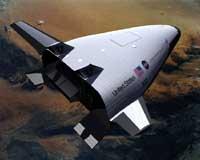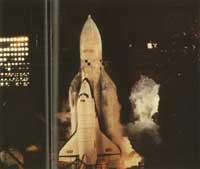Altius, Citius, Fortius... cheaper!
2000/12/01 Mujika, Alfontso - Elhuyar Fundazioa Iturria: Elhuyar aldizkaria
The exploration of space certainly advances. Since the launch of the first artificial satellite Sputnik in 1957, astronautics have come a great way. However, the launch of satellites or other space vehicles remains unsafe and is also expensive.
The scientific research of space and the main limitation of commercial exploitation of space today is the high cost of space extraction. Therefore, reducing the cost of launching satellites and increasing reliability and security are paramount objectives of the aviation industry. In addition, space transport is an activity that already has a nice market and in which we have fully entered the age of telecommunications, the satellite orbit market moves a lot of money. In these markets Americans, Europeans and Russians compete (and soon China could be next to compete).
The first satellite and spacecraft launch system, the most widely used yet, are the launchers. They are rockets that launch the corresponding load. For example, the pitcher Saturn was the one who launched the ships of the Apollo mission. And today, one of the most used is the pitcher Ariane of the European agency ESA. But they all have the problem that they can only be used once, that is, you need a new satellite launcher that comes out.
Reuse space vehicles
The first revolution occurred in 1981, when NASA launched the space shuttle. In fact, the space shuttle is both a launcher and a space vehicle and, although not complete, the main part can be used over and over again. That is their advantage. Its main part is the orbiter. Space plane: It can be placed in the orbit of the Earth and serve as a research platform to trap and repair satellites, such as the Hubble Telescope, and to carry and orbit satellites.
But the ferry is just the first step. Although the orbiter can be repeated, it is very expensive and security is not enough (remember that the Challenger ferry burst into the air on January 28, 1986). A significant fact is that whoever wants to space a charge (for example, a satellite) must pay 20,000 dollars per kilogram. The price and low level of reliability (errors and the resulting load loss are not rare) limit the exploitation of space.
To solve this problem, several programs have already been launched. NASA, as it could not be otherwise, remains a pioneer, but also in Europe since 1995 different sessions are being held. However, NASA is the most structured and detailed program. In 1994 NASA launched the Advanced Space Transport Program. The objectives of the program are not slow: to reduce the cost of a charge to a low Earth orbit of 20,000 dollars per current kilogram to 2,000 dollars by 2010: Reduce to $200 by 2025, leaving the cost below $100 per kilogram by 2040. In addition, cost reduction is accompanied by a significant increase in safety and reliability.
Achieving these objectives means fully overcoming current technologies. And some of these new technologies are yet to be discovered. The research will require large investments, but NASA believes that this expense will be totally profitable, since the launch cost is only about a quarter of the NASA budget.
The first step of this program is the second generation of space vehicles for reuse, which will replace the current space shuttle. This technology will be 10 times cheaper and safer than the current one. This has led to the development of the new vehicle structure and new propulsion technology. Develop and test. And to test new technologies, testing vehicles are being used: the so-called X-33, the most advanced, and the X-34 and X-37 vehicles.
But they also have longer-term goals and begin to foresee the third generation. NASA has developed a plan called Spaceliner 100. Spaceliner 100 is not a specific program for the design of a vehicle type, but is a basic program to identify and generate technologies that do not currently exist. Security is the primary priority of the analysis system established by the Plan. It is normal. The increase in the level of security means a direct cost reduction, since today, due to the lack of security, vehicles and satellites must be doubled preventively and insurance is very expensive. In addition, within 25 years, space transport will begin to become a reality for ordinary travelers. Therefore, from the beginning we must use a design philosophy based on security.
The construction of reuse space vehicles requires new materials. Minimize the dry mass of the vehicle (no fuel or load) This means that low density hard materials are needed. In addition, materials should work in a wide temperature range. It is one of the main technical challenges. Another is propulsion systems. There are two generic technologies: the current rockets carry, in addition to fuel, comburent (oxygen). But if atmospheric oxygen was used, it would be a great advantage. To do this, current propulsion atmospheric systems need much better.
The goal and deadlines are there. In 2010 you can check if what was said in these lines was a chimera.

Gai honi buruzko eduki gehiago
Elhuyarrek garatutako teknologia






